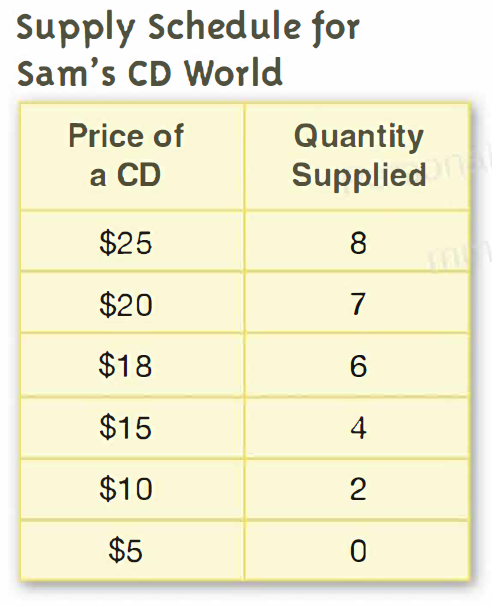Supply

In a market economy,
buyers want goods, and sellers provide them.
Supply is the number of
goods that is available to buy.
In this section, you
will learn how sellers decide how much to supply.
Key Terms
ü individual supply schedule: a chart that lists
the quantity of a good that one company will supply at different prices
ü law of supply: the higher the price of a good, the larger
the quantity of the good that will be produced
ü market supply schedule: a chart that lists the quantity of a
good that all companies in a market will supply at different prices
ü supply: the number of goods that are available to buy
ü supply schedule: a chart that lists the quantity of a good
that a company will supply at different prices
Let's
Practice!
Sellers want to make the largest profit
possible when they sell goods. Remember, profit is the amount of money that is
left over after production is paid for. For example, if it costs a company $5
to produce a music CD and sells it for $15, the company makes a profit of $10.
If the company raises the price of the CD, it will make a bigger profit.
The Law of Supply
Just like there is a law of demand, there is
also a law of supply. The law of
supply says that when the price of a good is higher, a larger quantity of the
good will be produced. When the price of a good is lower, a smaller quantity of
the good will be produced.
Take the example of music CDs. Imagine that CDs
are popular, so the price goes up. This is good for the seller because the
seller can make a bigger profit. Therefore, the seller produces more CDs to
sell at a higher price. At the same time, other sellers notice that CDs are
selling well, so they decide to sell CDs too. These sellers are following the
law of supply.
Just like the law of demand can be shown using
a schedule, the law of supply can be shown using a schedule. A supply schedule lists the quantity of a
good that a company will supply at different prices.
By looking at the chart, you can see that Sam's
CD World supplies fewer CDs at lower prices. The chart at left shows the supply
schedule of ONE company, so it is called an individual supply schedule. A market supply schedule lists the quantity
of a good that ALL companies in a market will supply at different prices. A market supply schedule will have larger
quantities supplied than an individual schedule, but otherwise, they are the
same.

Supply does not refer to only physical things
like CDs. For example, you are a supplier when you look for a job because you sell
your services. Your labor is what you supply. Just like the owner of the CD
store, you would be willing to supply more labor for a higher price.
Think about how much you study each night. What
if you were paid $5 for each hour that you studied? What if the price increased
to $50 per hour? You should study more for a higher price.

Let's
Practice!